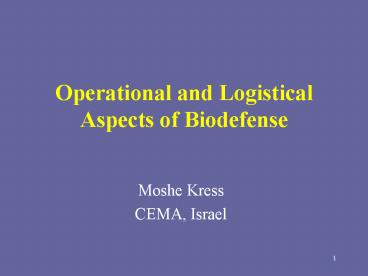Operational and Logistical Aspects of Biodefense - PowerPoint PPT Presentation
1 / 25
Title:
Operational and Logistical Aspects of Biodefense
Description:
1. Operational and Logistical Aspects of Biodefense. Moshe Kress. CEMA, Israel. 2. The Situation ... Biodefense involves many logistical aspects: ... – PowerPoint PPT presentation
Number of Views:24
Avg rating:3.0/5.0
Title: Operational and Logistical Aspects of Biodefense
1
Operational and Logistical Aspects of Biodefense
- Moshe Kress
- CEMA, Israel
2
The Situation
- A malevolent agent spreads a disease (massive
effect, possibly multiple sites, combined with
other hostile acts). - The event may be noisy or silent.
- The disease may be contagious (e.g., Smallpox) or
not (e.g., Anthrax) - Possible states of infection (epidemic)
- Asymptomatic (vaccine sensitive? infectious?)
- Symptomatic (isolated?)
- Removed (recovered, dead).
3
Epidemic Spread Mechanism
- Homogeneous (free mixing).
- Spatial ? Commuting Pattern.
(City, Region)
(State, Nation)
4
Overview
- General Introduction
- Response actions
- Types of decisions and corresponding OR
methodologies - The uncertainties
- Case study Using OR to set up a mass-vaccination
process - Facilities
- External Flow
- Queuing
5
Possible Response Actions
- Quarantine
- Isolate
- Impose preventive measures
- Screen susceptibles
- Vaccinate
- Trace contacts
- Restrict travel (immobilization)
- Monitor the Epidemic
- Eliminate the threat.
6
Types of Decisions
- Structural level decisions to be implemented
prior to the attack. Are associated with
preparedness issues. - Operational level decisions to be implemented
after the attack has occurred.
7
Structural Level Decisions
- Physical Infrastructure (vaccination centers,
isolation facilities) location models, LP/MIP - C3 systems (detection, tracing, coordination,
projection) information theory, statistical
inference, forecasting - Vaccination policy (preattack/postattack, mass,
ring) decision theory, differential/difference
equations - Manpower (doctors, nurses, administrators,
tracers) probability models, queuing models - Vaccine inventories (supply level, deployment,
control) inventory models, stoch. prog. - Intelligence (counter bioterror) LP.
8
Operational Level
- Supply chain (vaccines and other supplies).
- Allocation and routing (to vaccination centers,
isolation facilities). - Queuing at vaccination centers.
- Operation Management (vaccination centers,
isolation facilities, quarantines, imposing
travel limitations) - Contact-tracing process.
- Eliminating the threat
- Providing general support (food, utilities)
Real-Time DSS
9
Example Supply Chain
X1 X2 X3 X4
Federal
....
State
State
State
..
..
..
Local
Local
Local
Local
..
..
..
..
VC
VC
VC
VC
VC
10
The Uncertainties
- Location(s) of the attack
- Infection spread rate and distribution
- Transportability
- Contra indications
- Population behavior
- IF
11
Pre-Attack vs. Post-Attack Action
Pre act iff p1C1 (1-p1)C2 lt p2C3
12
Special Cases
p2
- C1 C2lt C3 Pre-action is effective - no
additional cost if attacked ? Pre-act iff
p2 gt C2 / C3 - C1 C3gtgtC2 The cost of the pre-action itself is
negligible ? pre-act even if there is no cost
effect to the pre-action (because we move from p2
situation to p1 situation and p1 ? p2) - C1 C3 C2 C pre-action results in a certain
cost C. The cost of no action is p2C ? Never
pre-act
C2 / C3
-C2 / (C1-C2)
p1
p2
0
p1
0
p2
1
p1
13
Case Study Time-Constrained Vaccination Process
- Decision Issues
- Facilities for vaccination centers.
- External flow control.
- Functional and operational design of a
vaccination center.
14
Determining the Facilities for the Vaccination
Centers
- Space needed for operating the various positions.
- Economies of scale.
- Risk pooling
- Clinics needed for regular medical help
- Relatively Few Large Facilities
15
Risk Pooling
- Population of size P
- V vaccination centers
- n servers per center
- P/V individuals at each center
- Service time at each server Exp(? )
- Total processing time at each center ?(n?, P/V)
- ?(n?, P/V t)V gt ?((n/k)?, P/kV
t)kV , k gt 1. For t gt t
16
External Flow Control
- Specific vs. non specific allocations to VCs
(enhance flexibility). - Coordinate the inflow (schedule alphabetically).
- Traffic control in the vicinity of the VC.
17
Design of a Vaccination Center
- Determining the stations (registration,
information, screening, vaccination) - Number of positions at each station
- Operating procedures of a position at each
station - Internal flow control
18
The Queuing Network
(Finite population)
Entrance
(Contra indications)
Registration Information
Screening
Vaccination
Exit
19
The Flow in a Vaccination Center
20
Vaccination Center Cont.
21
Vaccination Center Cont.
22
Vaccination Center Cont.
- The problem Given nl m ? n? l? k?
23
Vaccination Center Cont.
- The fluid-balance relations
24
Vaccination Center Cont.
25
Summary
- Biodefense involves many logistical aspects
- Capacity planning (isolation, quarantine,
vaccination) - Resource allocation (medical supplies, personnel)
- Operations management (emergency rooms,
vaccination centers, isolation facilities,
connectivity control, general support) - The decision problems involve
- Setting up an appropriate infrastructure
- Pre allocation of resources
- Determining operation policies
- Real-time responses to various contingencies































